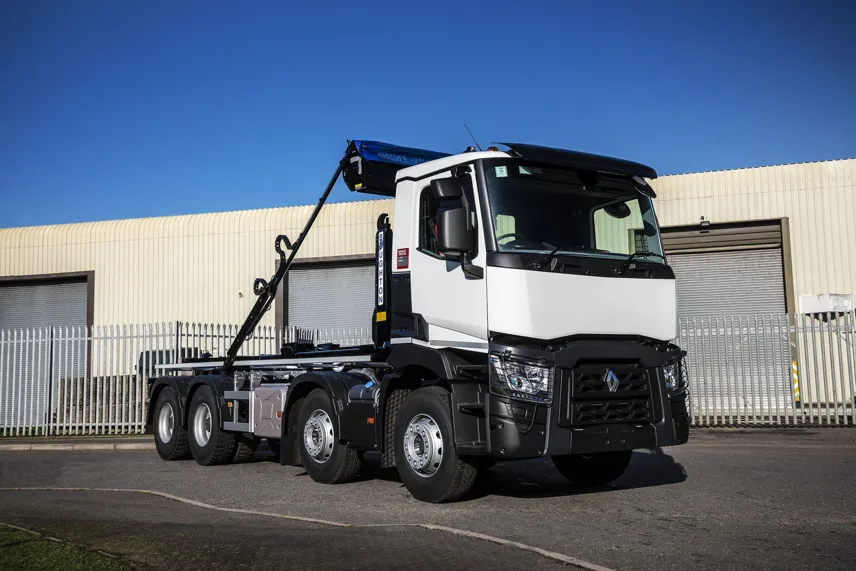Review
As we all know there are many aspects to off-road transport, for example from muck-away to aggregates, from cement mixers to hookloaders and all things in between.
This creates a slight dilemma for truck manufacturers when looking to provide the key features needed for each operation which in many cases maybe completely at odds with each other. Take a “muck away” operation where chassis strength and the ability to take shock loadings are a perquisite, resulting in a heavy chassis weight to ensure reliability and durability. This is at odds with an aggregate operation where in most cases a high payload and fast turn round are the operational “gods” but a manufacturer has to cater for all.
As a result, we end up with two if not three basic types of offerings for the multi-wheeler operators, and Renault Trucks is no different in this matter, they offer two very diverse ranges, the “C” and “K” range.
The “K” range could be best described as the heavy end of the construction sector, with operators looking for a “strong” chassis usually working in the logging, mining and muck-away sector.
The “C” range is more your everyday truck, walking the everyday fine line between high payload (and therefore high earnings) and reliability / durability that is the norm in this sector. In fact to meet the potential needs of this diverse market, Renault Trucks even has two “C” ranges, one is a two and three axle range featuring the narrow 2.3 “D” range cab and then a two / three and four axle range featuring the much higher and wider 2.5m “T” range cab.
For our road test this month we are looking at the latter four axle “C” range with the “T” cab and this was complete with a hookload system by Boughton Engineering.
The big cab “C” range features the familiar group engines in the shape of the DTi11 and DTi13, both have three power ratings, meaning the power ranges from 380bhp to 520 bhp.
Our vehicle had the middle power setting on the six-cylinder 10.8 litre DTi11 model, with a rating of 425PS (430 model) provided between 1,700 to 1,900rpm. The torque is 2050Nm and developed between 1,000 -1,400rpm, of course all under the Euro VI standards.
Behind the 11-litre engine sits Renault’s Optidriver ATO2612 automated gearbox with auto clutch and overdrive top gear, cased in an aluminium housing for light weight. Importantly for an off-road operator the power take off (S81) features a splined hollow shaft capable of providing 1,000Nm of torque with 0.9 / 1.14 ratios.
Braking for the “C” range starts with the OPTIBRAKE, boasting a power rating of 300 kW at 2300 rpm which works in conjunction with the exhaust brake and valve compression braking linked to the service brake which comprise of ventilated disc brakes all round. The electronic braking systems feature all the standard items you would expect of a vehicle going on and off road such as Hill Start Aid, Wheel anti spin regulation (ASR), brake pad wear balancing (discs) Wheel antilock braking system (ABS) and Emergency braking assist (AFU).
The four axle rigid features two leaf springs on the front two axles with stabiliser bars and the rear suspension has air suspension and stabiliser bars as well as rear shock absorbers, with the system controllable via a remote pad. The front axles are rated at 8 tonnes each and the rear bogie at 21 tonne and, of course, its limited to a gross vehicle weight of 32 tonne.
The wheelbase, measured from the centreline of the front axle to the centre of the third axle is 5100mm, although a more realistic wheelbase is 5775mm, where the centre of the rear bogie is taken into consideration, and this allows for a minimum body length of 7499mm to a maximum 10890mm.
As explained in the introduction the “C” series has two cabs from two and three axles, but the four axles variant all have the larger 2.5m wide cab. There are a number of cab variants from a day cab with a standard roof to a sleeper cab with a high roof. Our vehicle featured the normally specced day cab for this type of operation and it sits on a four-point cab air suspension with ride-height control system.
First, it has to be said, this is a big cab and judging by the four steps (including cab floor) necessary to get into the cab, a tall one, entering the cab and having a quick look round immediately confirms that outside impression!
The dashboard is a semi-wrapround design and combined with a slight engine hump it means across cab access is limited but in many situations that’s not an issue.
The instrument panel is a mixture of digital and analogue with a seven-inch central LCD screen flanked by a large rev counter to the right and three small dials for fuel, air pressure and water temperature.
Both the driver’s and passenger seats are air-suspended with fitted seat belts, and the drivers has an adjustable lumbar support, adjustable seat cushion extension, and is heated.
All the heating and ventilation controls are on the angled central panel which also has houses a ROADPAD+ system comprising of an additional seven-inch colour touchscreen and truck specific TOM TOM navigation system.
Once on the road, the big cab offers excellent forward vision on the dual carriageways and motorways and the Opticruise gearbox changes up seamlessly at around 1150rpm , and settles at around 1,350rpm at 90kph which means its well within the 1,000-1,500rpm fuel economy range.
Renault Trucks have a great range of trucks to offer multi-wheeler operators and the C430.32 is an ideal hookloader vehicle with excellent driveline and great space in the cab.















